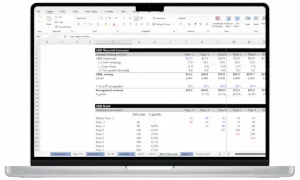What Is the SaaS Magic Number?
The SaaS Magic Number is a metric that defines sales efficiency.
It is defined as the ratio between new recurring revenue and the last period’s marketing costs. It is usually calculated quarterly, as the sales and marketing expense numbers are usually reported quarterly from accounting.
The SaaS magic number answers the question: How efficient were those marketing costs at converting prospects into customers? Alternatively, how well did the company do at converting dollars spent into new revenue dollars?
A “magic number” close to 1 means that the company is close to a 1-to-1 ratio of dollars spent to dollars earned in a year. The simplicity of 1 as the “magic number” means that it is easy to remember and calculate.
The “magic number” was created as a way to establish a uniform standard to measure sales efficiency in SaaS companies.
How to Calculate the SaaS Magic Number
The SaaS magic number includes recurring revenue from new customers, as well as expansion revenue from existing customers with no differentiation.
It looks at the new recurring revenue generated in a quarter, annualizes that amount, and compares that to the cost of the marketing and advertising used to generate that revenue. It looks like this:
((Current quarter’s ARR – Last quarter’s ARR) x 4)/Last quarter’s marketing expense
This answers the question: will the marketing expense used to generate that increase in revenue be recouped to the company within a year’s time?
This version of the magic number is useful if you are calculating metrics internally for your own company. Or, if you are an investor with access to the company in question’s financials, you would also be able to use ARR as the revenue figure for the magic number calculation.
Suppose, though, that you wanted to assess a competitor’s magic number and compare efficiencies. Rival SaaS companies aren’t going to share their ARR figures, so we have to find another way.
The accepted standard for SaaS companies to calculate the magic number without ARR is to use quarterly GAAP revenue and marketing expense from the income statement.
The magic number formula would then look like this:
((Current quarter’s GAAP revenue – Last quarter’s GAAP revenue) x 4)/Last quarter’s marketing expense
While GAAP numbers are not going to match perfectly to ARR, it is a close enough approximation. This is a good way to assess the productivity and efficiency of an SaaS company without direct access to the company’s financial records.
SaaS Magic Number Example
For the purposes of this example, we’ll stick to using ARR for the magic number calculation instead of GAAP revenue.
Suppose that Company A had a Q1 ARR of $450,000 and a Q2 ARR of $475,000. Marketing expense in Q1 was $100,000. Let’s look at the magic number with these figures.
((650,000 – 630,000) x 4)/100,000 = 0.8
This is a strong magic number. While a magic number of 1 is the ideal unicorn figure, and anything over 1 is a great efficiency, a magic number anywhere over 0.75 is considered healthy.
This magic number of 0.8 means that the company will make 80 cents of their marketing dollar spent in one year.
In other words, by Q1 next year, assuming zero churn, they will have made 80 cents back of every dollar in this year’s Q1 marketing spend.
Now let’s look at Company B. Their Q1 revenue was $600,000 and Q2 revenue was $620,000. Their marketing spend in Q1 was $125,000. Now the magic number formula looks like this.
((620,000 – 600,000) x 4)/125,000 = 0.64
Now it’s starting to not look so good. With this magic number, the company would only make back 64 cents of each marketing dollar they spent in Q1 by next year’s Q1.
There are a number of things they can do to improve this figure. We’ll look at those in a bit.
Why is the Magic Number important?
The Magic Number gives companies a way to look at their sales efficiency.
If the magic number is high, their marketing dollars are generally going to good use and increasing sales well. However, it could also mean that the company should be spending more on marketing and sales for even greater impact, and they are missing out on opportunities to grow revenue faster. In essence, they are leaving attractive growth opportunities on the table.
A low magic number could indicate a number of different problems for the company. Are they overspending on marketing? Are they marketing inefficiently, i.e. to the wrong customer base? Is their product simply not satisfying a market need, and customers just aren’t interested or are churning?
Despite its name, the magic number isn’t a magic wand. A poor magic number cannot actually tell CFO’s and investors what the problem is for the company, just that there is a problem. Combining the magic number with other SaaS metrics can help.
Another use case for the magic number is in the budgeting process. If the company has a specific revenue goal, or a revenue-to-marketing expense ratio they are aiming for, they can use the magic number to assess whether they are hitting a sweet spot for that ratio.

- 33 lessons
- 8+ video hours
- Excels & templates
What is a good Magic Number for SaaS?
The ideal magic number is 1. This indicates that the company will make back its quarterly marketing spend in new revenue within 12 months of the expense.
However, this is more of an ideal than an actual benchmark for most companies. Investor Lars Leckie summarized it when he said:
“Fundamentally, the key insight is that if you are below 0.75 then step back and look at business. If you are above 0.75 then start pouring on the gas for growth because your business is primed to leverage spend into growth. If you are anywhere above 1.5 call me immediately.”
A magic number below 0.5 is a sign that you are not growing efficiently. Why? It could be that you have a product that no one wants. It could be something people want, that isn’t positioned correctly.
Your marketing dollars might be aimed at the wrong prospective customers. You might have to take a look at your churn rate to see why revenue isn’t growing. In any case, it is not the time to invest more into marketing – without a course correction for efficiency, you’d just be wasting your money.
Between 0.5 and 0.75, you’re looking at a mixed situation. You could be having growth problems, or you could just have a new product that hasn’t gained enough market traction yet.
A magic number above 0.75 is considered efficient, and anything above 1 is considered very efficient.
How to Improve the Magic Number
There are two main ways to improve the magic number: marketing efficiency and churn reduction.
Marketing efficiency helps the company achieve an increased return on marketing and sales dollars spent. Churn chips away at growth over time, as new customers have to be more than enough to balance the churned ones.
Since the magic number does not discriminate between expansion revenue and new recurring revenue, you can focus your marketing efforts on upsells and cross-sells. If there is growth potential in your existing customer base, this can be a way to increase marketing efficiency. Alternatively, you can try creative marketing methods such as referral incentives to create more new sales with less spend.
Since the magic number is heavily concerned with growth, it is also in the company’s interest to reduce churn as much as possible to speed up growth. This could be through downgrading membership rather than cancelling subscriptions, good onboarding and education, and exit surveys for the customers who do churn.
Related Efficiency Metrics
As we’ve seen, the magic number is most useful when combined with related metrics.
Customer Acquisition Cost (CAC)
If you thought that the magic number sounded a whole lot like CAC and CAC payback period, you’d be right.
The difference is that CAC payback period factors in the gross margin, while the magic number does not. This makes CAC payback slightly more useful for actual analysis, as it shows how much of your revenue dollar is actually available in profit after expenses.
Think of the magic number as the “quick-and-dirty” metric, while CAC payback allows you to drill into the details.
Churn
Since one of the key ways to improve the magic number is through churn reduction, it makes sense to keep an eye on churn alongside the magic number.
This is especially important if you have a less-than-ideal magic number that needs some improvement. However, this metric may be difficult to obtain if you are analyzing a competitor.
Gross Margin
The magic number is only concerned with revenue and revenue growth rate. It doesn’t factor in profit margins, which are cut into by high marketing spends, or how high revenue is to begin with. Looking at gross margin alongside the magic number brings more clarity to the company’s financial picture.
Next Steps
To go even further in-depth, you can visit my SaaS metrics overview or enroll in my comprehensive online course covering SaaS metrics and financial modeling. These skills are essential for growth, venture, and private equity investors alike!


 SaaS & Growth Metrics
SaaS & Growth Metrics Break Into Growth Equity
Break Into Growth Equity
